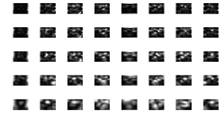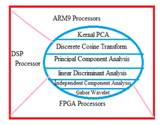 |
||||||
|
|
Home| Journals | Statistics Online Expert | About Us | Contact Us | |||||
 |
||||||
| About this Journal | Table of Contents | ||||||
|
|
[Abstract] [PDF] [HTML] [Linked References]
Performance Evaluation of Statistical Approaches of Face Recognition Techniques
Ruzal N. Surti*, Anjana Rodrigues** Electronics Department, MPSTME, Mumbai, Maharashtra, INDIA. Corresponding Addresses: *[email protected], **[email protected]
Research Article
Abstract: In today’s era of demanding technology of security and detection through images, Face recognition is one of the most relevant applications of image analysis and it has received substantial attention from both research communities and the market as face recognition. It’s a true challenge to build an automated system which equals human ability to recognize faces. This paper contains a survey on various statistical Techniques of face Recognition and evaluation of each. Images containing faces are normally represented as high-dimensional pixel arrays and often belong to a manifold of lower dimension. The dimensionality means the number of coordinates needed to specify a data point - of this data is too high. So the objective is to choose and apply the right statistical tool for extraction and analysis of the underlying manifold. One of the most relevant techniques is Principal Component Analysis (PCA).The main concern is regarding the memory needed to store the images for further process. PCA is the technique to reduce dimensionality of multi dimensional data by extracting principle components from it and however provides good statistical Analysis. Keywords: Face Recognition; PCA; Dimensionality Introduction Human beings can distinguish a particular face from many depending on a number of factors. One of the main objectives of computer vision is to create such a face recognition system that can emulate and eventually surpass this capability of humans. In recent years we can see that researches in face recognition techniques have gained significant momentum. Though it is much easier to install face recognition system in a large setting, the actual implementation is very challenging as it needs to account for all possible appearance variation caused by change in illumination, facial features, variations in pose, image resolution, sensor noise, viewing distance, occlusions, etc. Many face recognition algorithms have been developed and each has its own strengths The complex task is recognition of human faces and even though they are full of information ,working with all the information is time consuming and less efficient. It is better get unique and important information and discards other useless information in order to make system efficient. As there are many areas named Information Security, Access Management, Biometrics, Law Enforcement, Personal Security all have applications which use face recognition, the technologies are evolved through years for research in this field which allows a new way to interact with machines. There are many approaches for face recognition like Geometric or Template Based approaches, Piecemeal or Wholistic approaches, Appearance-based or Model-based approaches, statistical or neural network approaches etc.This paper presents a survey on the state-of-art face recognition research and systematically classifying face recognition methods. Generic Face Recognition SystemFace Recognition is a term that includes several sub-problems. The input of a face recognition system is always an image or video stream. The output is an identification or verification of the subject or subjects that appear in the image or video. Face recognition can be carried out in three steps. Face Detection and Feature Extraction phases could run simultaneously.
Figure 1: A Generic Face Recognition
Face detection is defined as the process of extracting faces from scenes. So, the system positively identifies a certain image region as a face. This procedure has many applications like face tracking, pose estimation or compression. The next step -feature extraction- involves obtaining relevant facial features from the data. These features could be certain face regions, variations, angles or measures, which can be human relevant (e.g. eyes spacing) or not. This phase has other applications like facial feature tracking or emotion recognition. Finally, the system does recognize the face. In an identification task, the system would report an identity from a database. This phase involves a comparison method, a classification algorithm and an accuracy measure. The usage of a mixture of techniques makes it difficult to classify these systems based on what types of techniques they use for feature representation or classification. To have clearly categorized it, we have following categories.
Orientation of paper Section I contains basic introduction with face recognition and applications of face recognition. Literature survey based various techniques are explained in Section II. In Section III theoretical Analysis with respect to all techniques of face recognition is given. Finally Section IV contains conclusion with future enhancements. Face Recognition Techniques Images of faces, represented as high-dimensional pixel arrays, often belong to a manifold of lower dimension. In statistical approach, each image is represented in terms of d features. So, it’s viewed as a point (vector) in a d-dimensional space. The dimensionality -number of coordinates needed to specify a data point- of this data is too high. Therefore, the goal is to choose and apply the right statistical tool for extraction and analysis of the underlying manifold. Principal Component AnalysisThe Principal Component Analysis (PCA) is very used in face recognition, is a powerful algorithm based feature extraction technique, which applies the Karhunen-Loéve transform to a set of training images and derives a number of projection axes that act as the basis vector for the PCA subspace. All images of know faces are projected onto the face space to find set of weights that describe the contribution of each vector. For identify an unknown person, his normalized image is first projected onto face space to achieve its set of weights. Than we compare these weights to sets of weights of known persons from the data bases. If we consider the image elements are the random variables, the PCA basis vectors are defined as eigenvectors of scatter matrix ST. Let Xnxm be the data matrix where x1,..., xm are the image vectors (vector columns) and n is the number of pixels per image. The KLT basis is obtained by solving the Eigen value problem. ɸΛɸ where Cx is the covariance matrix of the data X = UDV T (3) It is known that U = Discrete Cosine TransformThe Discrete Cosine Transform known as DCT expresses a sequence of data points in terms of a sum of cosine functions oscillating at different frequencies. It has strong energy compaction properties. Therefore, it can be used to transform images, compacting the variations, allowing an effective dimensionality reduction. They have been widely used for data compression. The DCT is based on the Fourier discrete transform, but using only real numbers. Let B be the DCT of an input image A NxM:
(4)
αp
αq Where M is the row size and N is the column size of A. It can be truncate the matrix B, retaining the upper-left area, which has the most information, reducing the dimensionality of the problem. Linear Discriminant AnalysisFisher faces is the direct use of (Fisher) linear discriminant analysis (LDA) to face recognition.LDA searches for the projection axes on which the data points of different classes are far from each other while requiring data points of the same class to be close to each other. Unlike PCA which encodes information in an orthogonal linear space, LDA encodes discriminating information in a linearly separable space using bases that are not necessarily orthogonal. It is generally believed that algorithms based on LDA are superior to those based on PCA. However, other work such as [7] showed that, when the training data set is small, PCA can outperform LDA, and also that PCA is less sensitive to different training data sets. Gabor WaveletGabor wavelets were introduced to image analysis because of their similarity to the receptive field profiles in cortical simple cells. They characterize the image as localized orientation selective and frequency selective features. Therefore, low level features, such as peaks, valleys and ridges are enhanced by 2-D Gabor filters. Thus, the eyes, nose and mouth, with other face details like wrinkles, dimples and scars are enhanced as key features to represent the face in higher dimensional space. Also, the Gabor wavelet representation of face image is robust to misalignment to some degree because it captures the local texture characterized by spatial frequency, spatial position and orientation. The convolution process can be taken in the Fourier domain for fast computation. In the face recognition community, many researchers13-17 have widely used the magnitude of Gabor filters for face representation. Here 5 frequencies and 8 orientations are used; figure bellow shows the 40 Gabor Kernels in equation 13 used. Daugman generalized the Gabor function to the following 2D form:
Figure 2: Real part of 40 Gabor Karnels
Figure 3: Magnitude of Gabor faces Independent Componenet AnalysisIndependent Component Analysis aims to transform the data as linear combinations of statistically independent data points. Therefore, its goal is to provide an independent rather that uncorrelated image representation. ICA is an alternative to PCA which provides a more powerful data representation [12]. It’s a discriminant analysis criterion, which can be used to enhance PCA. The ICA algorithm is performed as follows [4]. Let cx be the covariance matrix of an image sample X. The ICA of X factorizes the covariance matrix cx into the following form: Cx = F∆FT where ∆ is diagonal real positive and F transforms the original data into Z (X = FZ). The components of Z will be the most independent possible. To derive the ICA transformation F,
Where X and Ʌ are derived solving the following eigen problem:
Then, there are rotation operations which derive independent components minimizing mutual information. Finally, normalization is carried out. Locality Preserving ProjectionsThe Locality Preserving Projections (LPP) was introduced by him and Niyogi. It’s an alternative to PCA, designed to preserve locality structure. Pattern recognition algorithms usually make a search for the nearest pattern or neighbors. Therefore, the locality preserving quality of LPP can quicken the recognition. Let m be the number of points that we want to map. In our case, those points correspond to images. The LPP algorithm has four steps: .Constructing the adjacency map: A graph G with m nodes is built using, for example, k-NN algorithm. .Choosing the weights: Being Wija weight matrix, we can build it using a Heat kernel of parameter t -if nodes i and j are connected. Solving the eigenproblem. D is a diagonal matrix where its elements are defined as dii = Pj wij, and L=D-W is the Laplacian matrix. Kernel PCAThe use of Kernel functions for performing nonlinear PCA was introduced by Scholkop fetal [19]. Its basic methodology is to apply a non-linear mapping to the input (ψ (x): RN - RL) and then solve a linear PCA in the resulting feature subspace. The mapping of ψ(x) is made implicitly using kernel functions k(xi, xj) = (ψ(xi) ・ψ(xj)) (10) Where n the input space correspond to dot- products in the higher dimensional feature space. Assuming that the projection of the data has been centered, the covariance is given by Cx =<ψ(xi),ψ(xi)T >, with the resulting eigen problem: λV = CxV (11) Novel Approach with PCA Technique The latest, less power consumptive, small size and fast working micro controllers can be used in Face recognition system. As face Recognition System uses an USB camera to take a snapshot of the users that are present in front of camera, the captured images are stored into NAND flash. Advanced security to identify particular criminal person based on the images stored already inside the data which are connected to the USB port of ARM9. The new technology can be designed based on face recognition algorithm to detect and extract the dimensionality features using PCA Technique which is highly recommended in real life now a day.
Figure 5: Statistical Approaches among Embedded System Processors
To Implement these Scheme on Hardware Platforms like DSP Processors, ARM Processors and FPGA to Proceed data fast and efficient is a challenging task. The figure above shows various approaches towards face recognition with Processors that can approach to implement it. However the main concern is in today’s era is to make efficient this concept as dimensionality reduction is concerned with noise removal, data compression as well as visualization. Conclusion The face recognition has many techniques but as far as new technologies grow up in areas of personal identification and securities, the terms regarding accuracy and efficiency are more to concern. This paper concludes that using PCA Technique, one can have the real output on processors. So for that to implement in real time applications, an approach can be made with ARM9 Processors to reduce the dimensionality of image and thus how reducing memory to store it and make processing faster.
|
|||||
|
||||||



